Pug
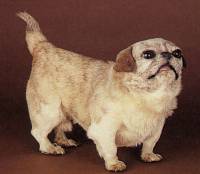 Chinese 'Happa' Dog
Chinese 'Happa' Dog
The Pug is one of the most popular breeds and quite unique in the Toy Group.This early dog pictured, a 'Chinese Happa Dog' named 'Hah-Bah', was exported from Peking in 1906 and preserved, mounted and on display at the British Museum of Natural History at Tring, UK[6].
History of the Pug
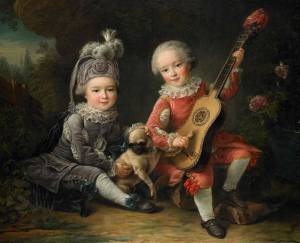 Pug, France 1761
Pug, France 1761
There is little doubt that Pug originated in China where it had existed for Centuries and was called the 'Lo-sze'[5].
Trade between China and the West began in earnest, firstly with Portugal in 1516, then with Spain and France in 1575. But when trade with the Dutch led to the founding of the East India Company, the Pug became known in England.
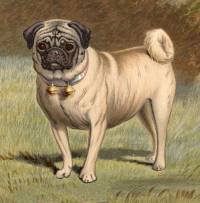 Pug 1879
Pug 1879
Meanwhile, Dutch born William III and his protestant wife Mary ascended the throne in 1688. As they opposed Catholic succession, members of the Royal household tied bows of orange ribbons with bells on them around the collars of their little Pugs. This expressed not only approval of their new protestant monarchs, their palace was called the "House of Orange', representing the colour of the Dutch Royal Family[7].
The Pug becomes a Pure Breed
Many early English paintings of portrayed Pugs with bells attached to their collars or orange coloured ribbons around their necks[4]. Consequently well before the Kennel Club began its records in 1864, and produced the First English Stud Book, the Pug had become a distinct type of dog and one of the few Toy breeds mentioned.
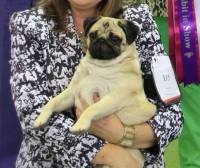 Pug
Pug
In addition to his shortness of coat, the Pug has elasticity of skin to a far greater degree than the Pekingese. This allows the Pug to be picked up by the scruff of the neck without pain[5]. But the point most sought after was the 'Prince' mark, formed by three wrinkles on the forehead with a vertical bar in imitation of the Chinese character for 'Prince'[5a]. This is the reason for the 'clearly defined thumb mark or diamond on forehead' demanded by today's Breed Standard.
History of Pugs in Australia
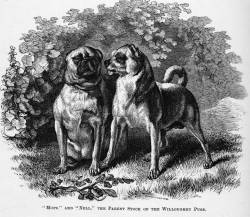 Pugs, England c 1872
Pugs, England c 1872
Pugs (except black) were among the earliest breeds to reach our shores. Two were entered at Melbourne's First Exhibition of Sporting and other dogs in 1864 - one being called a 'Japanese Pug'[1]. Some would have no doubt accompanied early immigrants and helped by masters of the vessels. Certainly Captain Wagstaff of 'La Hogue', a London registered migrant and cargo ship imported 'Romeo' and Juliet' for F Steven of Pitt Street. Sydney and later imported more Chinese Pugs' from the progeny of two of the Chinese Pugs taken from Peking in the 1860's. Another two were listed in the catalogue of a NSW Agricultural Show in 1870[2].
 Australian Pugs 1937
Australian Pugs 1937
Several other imports followed across Australia. Consequently, by the first decade of the 1900's, there were several breeders with 24 individual dogs being listed in Australia's first Stud Book[3]. However, it should be noted that Pugs (Black) were not represented in Victoria as of 1911[3]. Pugs in Australia have been popular for over a century with many famous breeders having exhibited and bred them consistently. Grace Lord in NSW, Esme and Jack Stringer and Elaine and Jock McRae and their daughter Leonie in Victoria have all specialized in Pugs for over half a century leaving them one of Australia's most popular toy breeds.
The Pug Today
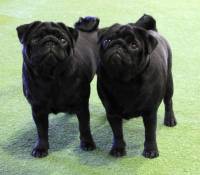 Pugs (Black)
Pugs (Black)
The Pug is a brachycephalic or short-faced Toy breed weighing just over 6-8 kg or 14-18 pounds. He should give the impression of the great charm and dignity of his aristocratic past. His fine, smooth, soft, short and glossy coat can be silver, apricot or fawn. If of any of these three colours, the Pug should have a clearly defined black mask and trace which is a black line extending from the occiput to the tail, making a complete contrast between the colour and the black. Unfortunately this is rarely seen in modern Pugs. Alternatively, he can be solid black.
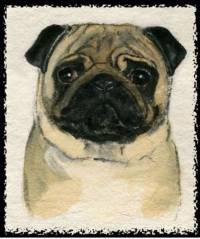 Pug
Pug
The Pug's head is large and round but the skull should never be domed. The wrinkles on the forehead should be clearly defined but the wrinkle over the nose should never be never so exaggerated that it affects the line of sight of the eyes or cover the nose. The nose should never have pinched nostrils. Instead the openings should be large and open so there is sufficient room to allow the free passage of air.
The wide muzzle is short and square with a slightly undershot mouth with the incisors preferably almost in a straight line. The Pugs' wonderful lustrous eyes are not too large, should always be dark in shape and round, but never protruding giving a soft, solicitous expression. The ears are small and thin and can be either rose-shaped or button ears.
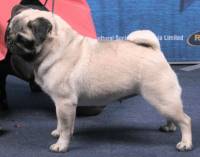 Pug (Fawn)
Pug (Fawn)
The strong neck should have a slight crest and sufficient length to carry the head proudly. The body of the Pug is described in the Breed Standard as 'multum in parvo' which means it is decidedly square and cobby with compactness of form. The Pug's front and back legs are of moderate length and well set under the body.
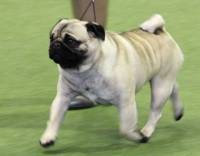 Pug
Pug
The back legs in particular are very strong with a good turn of stifle. The ribs are well sprung and carried well back giving a level topline which is neither roached nor dipping. Consquently the tail is high set, curled tightly over hip with a double curl highly desirable. A slight but not exaggerated roll of hindquarters typifies the Pugs' gait.
References and Further Reading
Published as - Jane Harvey "Ancient Breeds from Chinese Temples" Published in Dog News Australia (Top Dog Media Pty Ltd Austral NSW) Issue 1 January 2018, Pages 20 - 21
[1] Catalogue of the First Exhibition of Sporting & Other Dogs, Thursday & Friday April 7 & 8, 1864 promoted by the Council of the Acclimatisation Society, printed in Melbourne by Mason & Firth, Printers, Flinders Lane West
[2] "The History of Purebred Dogs in Australia" published by OzDog Newspaper 1997 , Pug by Jenny Jarvisto Page 250
[3] "Tyzack's Annual" Compiled by T. W.Tyzack and C.S.Turner Published by the Victorian Poultry and Kennel Club 1912 Printed by Bellamine Bros. Printers, 66-70 Flinders Lane Melbourne Importations Page 101; Stud Book Page 47
[4] Milo G. Denlinger "The Complete Pug" published by Howell Book House 575 Lexington Ave New York 22 N.Y.1947 Part 1 Origin and History Page 20
[5] V.W.F. Collier, 'Dogs of China and Japan' Published by Frederick Company 1921, Chapter 9 'Points of the Chinese Pekingese Type' Pages 164 and 168
[5a] ibid., Chapter 10, 'The Chinese Pug' Page 170
[6] Kim Dennis-Bryan and Juliet Clutton-Brock - 'Dogs of the Last Hundred Years at the British Museum' Published by British Museum (Natural History), London (1988) ISBN 0-565-01053-0 Page 101 Chinese Happa Dog
[7] Susan Graham Weall, 'The Pug' Published by Popular Dogs Publishing Co, London, 1965, Chapter 11, The Pug Comes to Europe Pages 16 - 19